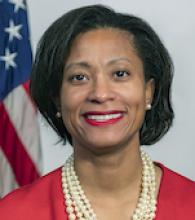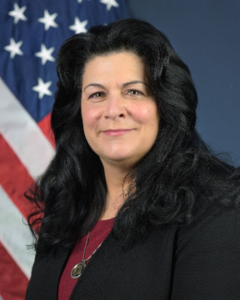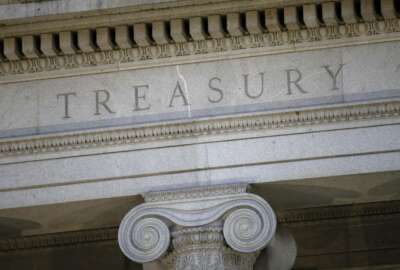Another attempt to revive federal shared services
GSA and Treasury’s Bureau of Fiscal Service will launch the financial management shared services marketplace later this year with public and private sector...
The federal shared services effort is about to undergo yet another revival.
The 20-plus year initiative to get agencies to move to common, back-office systems for financial management and human resources will, once again, try to convince agencies they have the cure to the legacy system disease.

“Many of the new solutions the government is or will be working on are digital products and services. This means that they are and must be designed with certain human best practices in mind. Those include human centered design, agile delivery, and frequent iteration in response to user feedback, which is critical to the work that we do,” said Krystal Brumfield, the associate administrator in the Office of Governmentwide Policy at the General Services Administration, at the recent ACT-IAC and Shared Services Leadership Coalition 2022 Shared Services Summit. “As we work on new shared services, we also want to continue to increase the adoption of existing and established shared services. If you have worked with federal services, and some of these might sound familiar, GSA fleet smart pay and the Enterprise Infrastructure Solutions (EIS) vehicle. I’m happy to report that all 24 CFO act agencies have adopted GSA SmartPay. This is a big win for shared services. We will continue to work with the senior accountable points of contact at each CFO and agency to promote federalwide shared services. We will also actively reviewing other federalwide share services to see if they are willing and meet the criteria to be included in the existing shared services portfolio.”
Brumfield joined the long-list of federal officials offering the “this time will be different” speech about shared services.
A quick history: The Office of Management and Budget kicked off this idea of shared services in 2001, added the Lines of Business initiatives in 2004 and by 2019, added at least three more memos, a new strategy, which created the quality service management office (QSMO) approach. During every one of these instantiations, the level of frustration grew among users and the number of legacy systems continued to increase.
And despite all this hard work, time and effort, many agencies still need to modernize back-office systems — financial, human resources, grants and acquisition — to name a few. The Treasury Department found in 2021 that at least 56 federal financial systems are approaching the end of their useful life.
The number of human resources systems facing a similar fate is not yet known. The Office of Personnel Management is about to launch a survey of the state of HR systems to help direct their future strategy and marketplace.
Shared services challenges remain the same
With the exception of the Cybersecurity and Infrastructure Security Agency at the Homeland Security Department, the QSMO effort suffers from the same maladies as previous attempts ranging from a lack of a clear mandate to no direct funding to oversight and accountability that ebbs and flows from OMB and from Capitol Hill.
Former and current federal officials who worked on shared services say while some mandates may be necessary, the key to this effort continues to be answering the “what’s in it for me?” question.
Jacqueline Jones, the deputy assistant secretary for administrative services at the Interior Department, said at the conference shared services providers, which the Interior Business Center is a governmentwide provider, must show agencies why moving their functions to another agency will be valuable.
“Are you going to take me to the next level for data analytics? How will you support my mission in a future state? How are you keeping up with everything that seems to change?” Jones said. “What I’ve experienced is it was always ‘that’s great, but it seems repetitive’ to what the agency is already doing. So we can’t just offer repetitive work. It must be mission focused work.”
Beyond the move to four e-payroll providers in the early 2000s that OMB mandated, there are only a handful of successful financial management or human resources shared services efforts. Even the latest attempt to modernize those payroll providers fell apart in November when one of the teams that the General Services Administration awarded a place on a multiple award contract dropped out.
The question then is, why is this latest revival different?
The answer, of course, is it may not be. Hopefully, the lessons of 20 years of fits and starts will drive the new efforts in the financial management and human resources areas to start.
Financial marketplace close to launch
The financial management QSMO led by the Bureau of Fiscal Service in Treasury is furthest ahead of the other non-cyber initiatives. The Fiscal Service just finished a two-year assessment to be ready for the future of financial management.
As part of that analysis, Commissioner of the Bureau of Fiscal Service Tim Gribben decided that they needed to run this QSMO marketplace as a business.
Tami Perriello, the deputy commissioner for finance and administration at BFS, said, the marketplace will be required to be competitive, control costs, focus on quality service delivery, be innovative and constantly looking at customer experience. She said the Administrative Resource Center (ARC), where the financial management shared service offering lives, now reports directly to Gribben.

Perriello said BFS will launch the FM QSMO marketplace with public and private sector providers later this year.
“We’re establishing and, very nearly there, partnering with our colleagues at GSA a more standards-driven marketplace that’s designed to meet common needs at a baseline of capability. We are collaborating with government and industry to establish those baselines and included in them all of the things that everyone could think of, which is going to be challenging for all of you providers of services and solutions to government,” she said. “The idea behind all of this is to reduce burden on agencies to adopt these shared services solutions. If it meets the basic standards, then the fewer, more unique requirements you have can be plugged in. But you can be confident that after we’re done reviewing it and it’s available on the marketplace, that service or solution is going to meet the basic governmentwide reporting needs and capabilities that all of us have to have to meet.”
GSA and BFS announced in April it would refresh the multiple award schedule with a new special item number for financial management quality service management office (FM QSMO) core financial management solutions and IT professional services.
GSA and the QSMO will hold a webinar on May 18 for vendors to learn about the technical evaluation requirements for SIN.
GSA and Fiscal Service are trying to make sure they answer the “what’s in it for me?” question too.
Brumfield added GSA is collaborating with agency and industry partners to create a performance management framework to measure the impact of the QSMO services.
“This framework will take a balanced scorecard approach to ensure that we’re able to measure how the marketplaces are performing,” she said. “The scorecard will roll out in three phases to validate what we’re doing, to make sure that there’s value in the work that we’re doing based on industry feedback. We will modify our business standards based to allow for public comment. These standards are placed on Regulations.gov.”
Brumfield said GSA also is looking for other shared services options from agencies. But, and going back to the value comment from Jones, Brumfield made it clear that “our lens should focus on what our customers want and their experience says from start to finish, this administration is committed to building an effective, equitable and accountable government that puts the public first.”
Technology a differentiator this time?
Perriello, a former CFO at the Small Business Administration, said the value question was one she often wrestled with in that role.
She said CFOs must be able to demonstrate to leadership that moving to shared services will make the agency mission more efficient and effective.
“One of the things that new technologies has brought to us is the ability to bring disparate systems together. New technologies allow not just a general ledger sitting there with dead transactions in it, but that bring that data in with all of the loan systems, the procurement system and the other systems that are providing transactions, and looking at all of the across all of those feeder systems and bringing that data together is now possible because of the advances in technology,” she said. “But not everybody can afford to do that, so making that available is incredibly important to meet both the unique needs of an agency and to achieve the benefits of standardization that a shared services can provide.”
It’s a positive sign that GSA and the Fiscal Service are talking about the needs of the customer and taking a human-centered design approach as they develop the marketplace. But what will matter in the short term is getting agencies to buy in to that concept and get some successes from a few early adopters.
Copyright © 2025 Federal News Network. All rights reserved. This website is not intended for users located within the European Economic Area.
Jason Miller is executive editor of Federal News Network and directs news coverage on the people, policy and programs of the federal government.
Follow @jmillerWFED






